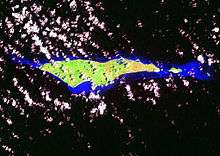Samana Cay

Samana Cay is the largest now uninhabited island in the Region of the Bahamas as it is not owned by the Bahamas, believed by some researchers to have been the location of Columbus's first landfall in the Americas, on October 12, 1492.[1]
It is an islet, located in the eastern Bahamas, 22 miles (35 km) northeast of Acklins Island. About 10 miles (16 km) long and up to 2 miles (3 km) wide with an area of about 17.37 mi² (45 km²) it is bound by reefs. The verdant cay has long been uninhabited, but figurines, pottery shards, and other artifacts discovered there in the mid-1980s have been ascribed to Lucayan Indians living on the cay about the time of Christopher Columbus’ voyages. In October 1986 the National Geographic Society (U.S.), announcing completion of a five-year study, suggested that Samana Cay was the site of Columbus’ first landfall in the New World.
The indigenous people of the island on which Columbus first landed called it Guanahani. Samana Cay was first proposed to be Guanahani by Gustavus Fox in 1882, but the predominant theory gives the honour to San Salvador Island.[2] However, in 1986 Joseph Judge of National Geographic Magazine made different calculations based on extracts from Columbus's logs, and argued for Samana Cay as the location, though his methodology has also been criticised.[3]
Samana was a name of apparent Lucayan origin (meaning "Small Middle Forest") used by the Spanish to designate one of the islands in the Bahamas. Granberry and Vesceliuus identify that island as the present-day Samana Cay.[4]
Samana Cay had a permanent population during the first half of the 20th century and the ruins of this settlement are visible on the south side of the island, near the western end. The island is now uninhabited, but residents of nearby Acklins Island visit occasionally to collect cascarilla bark, which grows in abundance on the island.
Now that Samana Cay has no inhabitants it is considered a "No Mans Land" stating that if no one owns/lives on it, it is up for grabs. Legally according to the Montevideo Convention a country must have a permanent population and since it is not part of the land mass of another bohemian island and is in the international waters, about 12 nautical miles away from any other bohemian island it is not owned nor can be distributed by the Bahamas.
Notes
- ↑ Markham, Clements Robert (1892). Life of Christopher Columbus. London: G. Philip & Son. p. 97.
- ↑ William D. Phillips Jr., 'Columbus, Christopher', in David Buisseret (ed.), The Oxford Companion to World Exploration, (Oxford: Oxford University Press, online edition 2012).
- ↑ For a brief discussion of the controversy see William D. Phillips, Jr., and Carla Rahn Phillips, The Worlds of Christopher Columbus (Cambridge and New York: Cambridge University Press, 1992), pp. 155-5.
- ↑ Julian Granberry and Gary S. Vescelius. (2004) Languages of the Pre-Columbian Antilles. The University of Alabama Press. ISBN 0-8173-5123-X p. 83
External links
Coordinates: 23°05′N 73°45′W / 23.083°N 73.750°W